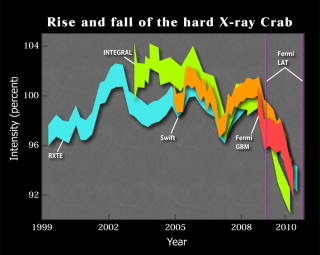- Joined
- Oct 30, 2009
- Messages
- 14,020
- Reaction score
- 4
- Points
- 0
The Italian Space Agency's AGILE satellite and NASA's Fermi Gamma-ray Space Telescope have together detected three bright gamma-ray outbursts from the nebula. The most recent outburst, in September 2010, lasted for four days and brightened the nebula by a factor of 6. Fermi's Large Area Telescope has recently detected two short-duration gamma-ray pulses coming from the Crab Nebula, which was previously believed to emit radiation at very steady rate. The pulses were fueled by the most energetic particles ever traced to a discrete astronomical object.
Tavani's team used the Italian Space Agency's AGILE satellite to observe flares in October 2007 and September 2010. Another team, led by Stefan Funk and Rolf Buehler at the SLAC National Accelerator Laboratory at Stanford University, observed the September 2010 flare as well, along with one in February 2009, using NASA's Fermi Gamma-ray Space Telescope.
Blandford was part of a KIPAC team led by scientists Rolf Buehler and Stefan Funk that used observations from the Large Area Telescope, one of two primary instruments aboard NASA's Fermi Gamma-ray Space Telescope, to confirm one flare and discover another. Their report was posted online in Science Express alongside a report from the Italian orbiting telescope Astro-rivelatore Gamma a Immagini LEggero, or AGILE, which also detected gamma-ray flares in the Crab Nebula.
These are the first such gamma-ray flares to be seen from any nebula. The cosmic particle accelerator in the Crab is speeding up electrons and positrons to nearly the speed of light. As a result, the gamma rays they release are of higher energies than any others ever before seen from astrophysical sources.
There are still many unanswered questions about the mechanism at work in the Crab Nebula, including why it flares up only periodically. The researchers hope to catch the Crab Nebula in the act of flaring up in the future, as well as to possibly observe the phenomenon in other nebulae.
Links:
"Our belief of a stable Crab got smashed completely — now we have to think again," said Marco Tavani, an astronomer at the INAF-IASF (Istituto Nazionale di Astrofisica-Istituto di Astrofisica Spaziale e Fisica Cosmica) in Rome. Tavani was lead author of one of two papers announcing the discovery of the flares in the Jan. 7 issue of the journal Science.
Tavani's team used the Italian Space Agency's AGILE satellite to observe flares in October 2007 and September 2010. Another team, led by Stefan Funk and Rolf Buehler at the SLAC National Accelerator Laboratory at Stanford University, observed the September 2010 flare as well, along with one in February 2009, using NASA's Fermi Gamma-ray Space Telescope.
"We were dumbfounded," said Roger Blandford, who directs the Kavli Institute for Particle Astrophysics and Cosmology, jointly located at the Department of Energy's SLAC National Accelerator Laboratory and Stanford University. "It's an emblematic object," he said. The Crab Nebula, also known as M1, was the first astronomical object catalogued in 1771 by Charles Messier. "It's a big deal historically," Blandford continued, "and we're making an amazing discovery about it."
Blandford was part of a KIPAC team led by scientists Rolf Buehler and Stefan Funk that used observations from the Large Area Telescope, one of two primary instruments aboard NASA's Fermi Gamma-ray Space Telescope, to confirm one flare and discover another. Their report was posted online in Science Express alongside a report from the Italian orbiting telescope Astro-rivelatore Gamma a Immagini LEggero, or AGILE, which also detected gamma-ray flares in the Crab Nebula.
These are the first such gamma-ray flares to be seen from any nebula. The cosmic particle accelerator in the Crab is speeding up electrons and positrons to nearly the speed of light. As a result, the gamma rays they release are of higher energies than any others ever before seen from astrophysical sources.
"The acceleration is about 1,000 times more energetic than the largest man-made particle accelerators, including Fermilab's Tevatron in Illinois and CERN's Large Hadron Collider in Geneva", Tavani said.
There are still many unanswered questions about the mechanism at work in the Crab Nebula, including why it flares up only periodically. The researchers hope to catch the Crab Nebula in the act of flaring up in the future, as well as to possibly observe the phenomenon in other nebulae.
Links:
- SLAC National Accelerator Laboratory: January 6, 2011 - Fermi's Large Area Telescope Sees Surprising Flares in Crab Nebula
- SPACE.com: Famous Crab Nebula Shoots Off Mysterious Flares
- NewScientist: Mystery flares betray hidden force within Crab nebula
- Space Daily: Fermi's Large Area Telescope Sees Surprising Flares In Crab Nebula



